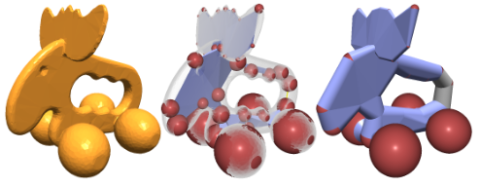Motivation
Displaying objects with levels-of-detail requires computing and storing meshes at several resolutions and also handling artifacts when switching between those. Seamless rasterization of features that are still rounded instead of triangulated at close distances is still a challenging task.
Description
We approximate meshes with few primitives with a method similar to sphere-meshes [1] that represents objects as parametrized transititions of spheres. We address the concavities that they cannot round off by exterior balls and define a signed distance function (SDF) that we display using raycasting at arbitrary resolutions without loss of detail or artifacts.
[1] https://dl.acm.org/doi/pdf/10.1145/2508363.2508384
Tasks (depending on PR/BA/DA and number of students)
- Construct a sphere-mesh that closely fits a triangle mesh, up to a defined error, e.g., with the Hausdorff metric
- Define the SDF that returns the distance for a primitive of the sphere-mesh (triangle with rounded edges/corners)
- Implement raycasting using a bounding volume hierarchy of the primitives of the sphere-mesh, on the GPU
- Evaluate runtime and error compared with levels-of-detail of triangle meshes
Requirements
- Knowledge of English language (source code comments and final report have to be in English)
- Knowledge of C++ is necessary, experience on CUDA or parallel programming a plus
Environment
The project should be implemented platform independent (Linux, Windows).
A bonus of €500/€1000 if completed to satisfaction within an agreed time-frame of 6/12 months (PR/BA or DA)
